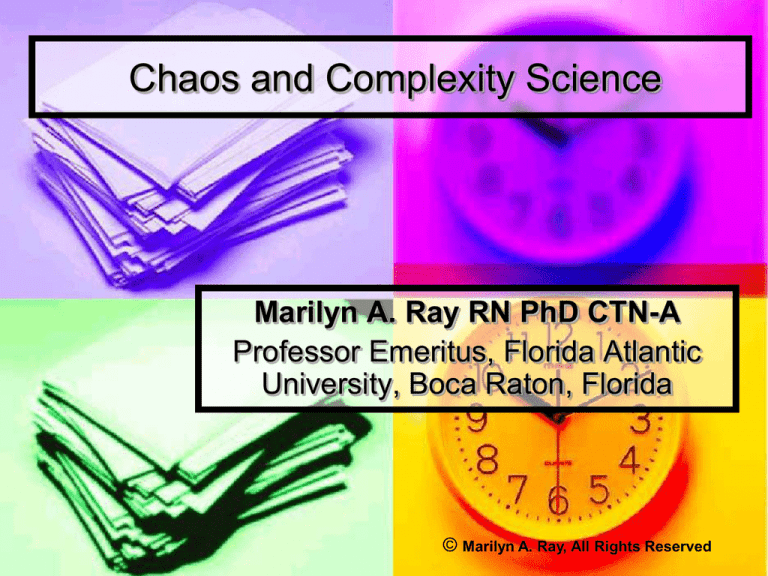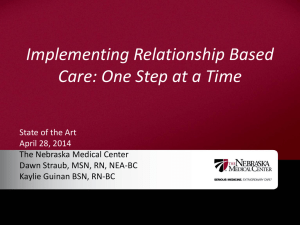
Chaos and Complexity Science
Marilyn A. Ray RN PhD CTN-A
Professor Emeritus, Florida Atlantic
University, Boca Raton, Florida
© Marilyn A. Ray, All Rights Reserved
CURRENT HEALTH CARE
NURSING ENVIRONMENT
Loss of Trust
Disillusionment with nursing
practice
Organizations driven by
economic survival
Decrease in loyalty to
organizations
Ray, M., Turkel, M. & Marino, F. (2002). The transformative process for nursing in workforce
redevelopment. Nursing Administration Quarterly, 26(2), 1-14.
THE NEW EVIDENCE
Transcultural Caring Dynamics
SocialCultural
Physical
Educational
Spiritual
- Ethical
Caring
Economic
Technological
Political
Legal
© Marilyn A. Ray, All Rights Reserved
Economic Caring
Economic Resources
Money
Goods
Services
Interpersonal Resources (Foa, 1971)
Love (caring)
Status (educational preparedness)
Information (education)
Ray, M. (1987). Health care economics and human caring: Why the
moral conflict must be resolved. Family & Community Health, 10(1),
35-43.
Classification System
of Caring
SpiritualEthical
Caring
© Marilyn A. Ray, All Rights Reserved
QUANTUM PHILOSOPHY
1.
2.
3.
4.
5.
What are the limits of human
knowledge?
Is the physical world shaped in some
sense by our perception of it?
Quanta are electromagnetic radiation
which comes in tiny bundles of
energy.
Uncertainty Principle: Unfolding of
quantum events-undulating waves of
possibilities.
Knowledge of nature fundamentally
limited: When we grasp one part,
another part slips from our grasp.
© Marilyn A. Ray, All Rights Reserved
QUANTUM PHILOSOPHY
(CONT’D)
6.
7.
8.
9.
Mystery of the wave/particle duality
in physics.
Quantum Phenomena are neither
waves nor particles but are
intrinsically undefined until the
moment they are measured.
Quantum state reflects not only
what we know about the system
but what is, in principle, knowable.
Reality is defined by the questions
we put to it (Einstein and Bohr).
© Marilyn A. Ray, All Rights Reserved
CHAOS AND THE SCIENCE
OF COMPLEXITY
CHARACTERISTICS
Non-Linear Dynamics: Shattered the
traditional notions of causality.
Classical Predictability Impossible:
Deterministic history does not bring
about predictable future
Randomness: No discernible
regularity or repetitive pattern.
© Marilyn A. Ray, All Rights Reserved
CHAOS AND THE SCIENCE
OF COMPLEXITY (cont’d)
Behind the apparent randomness lies
great beauty and structural symmetry
Knower and the known are one
All objectivity is subjectivity: What is
known, or the answer is shaped by the
observer in the action of observation
(the observer’s potential knowledge
changes).
Choice: The Conductor of the
Symphony (Davidson & Ray, 1991).
© Marilyn A. Ray, All Rights Reserved
The Holographic Theory of
Bureaucratic Caring
Physical
Educational
SocialCultural
Legal
SpiritualEthical
Caring
Technological
Political
Economic
© Marilyn A. Ray, All Rights Reserved
TRANSCULTURAL CARING
Transcultural Caring as
Critical Nursing Ethics:
Relationship between charity
and right action---compassion
and justice.
© Marilyn A. Ray, All Rights Reserved
Chaos Theory in
Nursing Practice
Ray, M. (1994). Complex caring dynamics: A unifying model of nursing inquiry. Theoretic and Applied Chaos in
Nursing, 1(1). 23-32. (Referred to now as Complexity and Chaos in Nursing).
ETHICAL ECONOMIC
CARING
Ray, M., et al., 1994. The edge of chaos: Caring and the bottom line. Nursing Management, 26(9), 48-50.
THE TIME IS NOW
Acknowledgements
Florida Atlantic University, The
Christine E. Lynn College of
Nursing, Boca Raton, Florida
Graphics Enhanced By:
M. Christopher Saslo PhD
VA Administration, WPB, FL
© Marilyn A. Ray, All Rights Reserved
References
Davidson, Ray, M.. & Turkel, M.. (2011). Nursing, caring, and complexity science: For humanenvironment well-being. New York: Springer Publishing Company. .
Dawes, M., Davies, P., Gray, A., Mant, J., Seers, K., & Snowball, R. (1999). Evidence-based practice.
Edinburgh: Churchill Livingstone.
Henry, J. & Henry, L. (2004). The soul of the caring nurse: Stories and Resources for Revitalizing
Professional Passion. Washington, DC: American Nurses Publishing.
Page, A. (Ed.). (2004). Keeping patients safe: Transforming the work environment of nurses. Washington,
DC: The National Academies Press.
Porter-O'Grady, T. & Malloch, K. (2003). Quantum leadership. Boston: Jones and Bartlett Publishers.
Ray, M. (1994). Complex caring dynamics: A unifying model of nursing inquiry. Theoretic and Applied
Chaos in Nursing, 1(1). 23-32. (Referred to now as Complexity and Chaos in Nursing).
Ray, M. (1998). Complexity and nursing science. Nursing Science Quarterly, 11(3), 91-93.
Ray, M. (& Turkel, M. 2010). The theory of bureaucratic caring. In M. Parker (Ed.), Nursing theories, n
ursing practice. Philadelphia: FA Davis Company.
Ray, M., Turkel, M. & Marino, F. (2002). The transformative process for nursing in workforce
redevelopment. Nursing Administration Quarterly, 26(2), 1-14.
Taylor, M. & Keighron, K. (2004). Healing is who we are...and who are we? Nursing Administration
Quarterly, 28(4), 241-248.
Turkel, M. & Ray, M. (2000). Relational complexity: A theory of the nurse-patient relationship within an
economic context. Nursing Science Quarterly, 13(4), 307-313.
Turkel, M.& Ray, M. (2001). Relational complexity: From Grounded Theory to instrument development and
theoretical testing. Nursing Science Quarterly, 14(4), 281-287.
Turkel, M. & Ray, M. (2004). Creating a caring practice environment through self-renewal. Nursing
Administration Quarterly, 28(4), 249-254.









